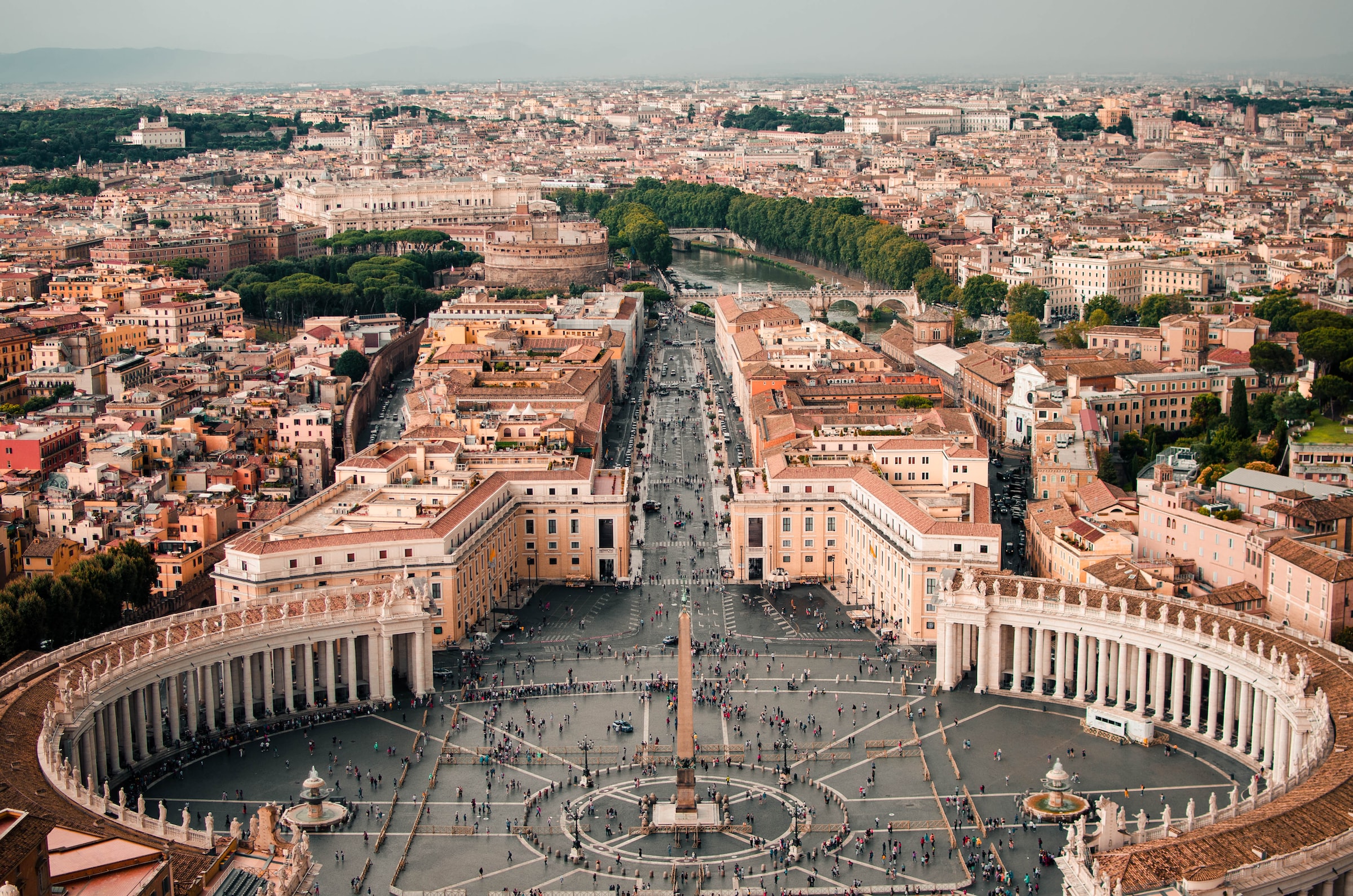St. Peter’s Square (Piazza San Pietro) in Vatican City is one of the most iconic and grand public spaces in the world, serving as a symbolic and practical center for events related to the Vatican and the Catholic Church. Designed primarily by Gian Lorenzo Bernini during the 17th century, the square is renowned for its impressive scale, harmonious architecture, and profound religious significance.
This sprawling piazza isn’t just a beautiful space; it’s a symbolic gateway to the Vatican and a place steeped in history, art, and religious significance. Whether you’re a Catholic pilgrim or simply a curious traveler, St. Peter’s Square offers a unique experience that will leave you in awe.
St. Peter’s Square Historical Background
Designed by the renowned architect Gian Lorenzo Bernini in the 17th century, St. Peter’s Square is a masterpiece of Baroque design. Imagine a vast elliptical space embraced by four majestic colonnades, each adorned with 140 statues of saints. These colonnades, like outstretched arms, welcome visitors into the heart of Catholicism. The central obelisk, an ancient Egyptian relic brought to Rome in the 1st century AD, adds a touch of history and grandeur to the scene.
The square takes its name from St. Peter, one of the twelve apostles of Jesus and the first Pope, who was martyred and buried nearby. The original square, dating back to the early Renaissance, was redesigned in the mid-17th century under the direction of Pope Alexander VII. Gian Lorenzo Bernini, a prominent Baroque architect and sculptor, was commissioned to create a monumental space that would serve as a fitting forecourt to St. Peter’s Basilica.
Architecture and Design

Colonnades
One of the defining features of St. Peter’s Square is its massive colonnades, which form a welcoming embrace around the square. Bernini designed these colonnades in the shape of two arms reaching out from St. Peter’s Basilica, symbolizing the Church’s maternal embrace of the faithful. The colonnades are made up of four rows of Doric columns (284 in total) and embrace elliptical curves, creating a sense of continuity and unity.
Obelisk
At the center of the square stands an ancient Egyptian obelisk, originally brought to Rome by Emperor Caligula in 37 AD and later moved to its current location by Emperor Nero in 37 AD. In 1586, Pope Sixtus V had it erected in the middle of St. Peter’s Square as a symbol of Christianity’s triumph over paganism. The obelisk, which stands at a height of 25.5 meters (84 feet), is topped by a cross that contains a relic of the True Cross.
Fountains
Bernini also designed the two fountains that flank the obelisk in St. Peter’s Square. The fountains, known as the Bernini Fountains, are adorned with sculptures of dolphins, dragons, and various animals, symbolizing the Church’s dominion over the natural world.
Religious and Cultural Significance
A Focal Point for Faith
St. Peter’s Square serves as a stage for major Catholic events. From weekly Papal audiences to momentous pronouncements, the square offers a platform for the Pope to connect with the faithful. Witnessing a large gathering here is a powerful experience, allowing you to feel the pulse of the Catholic Church.
St. Peter’s Square serves as a venue for major religious events and gatherings led by the Pope, including papal audiences, Masses, and the biannual Urbi et Orbi blessing. It can accommodate tens of thousands of people, who gather to witness these significant ceremonies.
Gazing Up at St. Peter’s Basilica
As you stand in the square, you can’t help but be captivated by the towering facade of St. Peter’s Basilica, the largest church in the world. The square’s design cleverly draws your eye towards the basilica, creating a sense of awe and pilgrimage.
Visiting St. Peter’s Square
Despite the crowds, St. Peter’s Square offers a sense of peace and reflection. People from all walks of life come here to pray, marvel at the architecture, or simply soak in the atmosphere. Sitting on a bench and watching the world go by allows you to contemplate the square’s historical significance and its enduring role in the Catholic faith.
Visitors to St. Peter’s Square are struck by its grandeur and sense of history. The vast space, surrounded by Bernini’s colonnades and overlooked by St. Peter’s Basilica and the Apostolic Palace, offers breathtaking views from every angle. Pilgrims and tourists alike gather here to absorb the spiritual and architectural beauty that the square embodies.
Visiting St. Peter’s Square is a must for any trip to Rome, Italy. Dress modestly, as you might be entering St. Peter’s Basilica. Be prepared for crowds, especially during peak season. Free guided tours are available in multiple languages, offering valuable insights into the square’s history and symbolism.
St. Peter’s Square is more than just a public space; it is a place where the spiritual and temporal aspects of Catholicism converge. With its monumental architecture, historical significance, and ongoing role in the life of the Church, St. Peter’s Square stands as a testament to faith, artistry, and the enduring legacy of Vatican City.
St. Peter’s Square transcends its role as a physical space. It’s a symbol of faith, a testament to artistic genius, and a place where history continues to unfold. So, next time you find yourself in Vatican City, take a moment to stand in the embrace of St. Peter’s Square and let its beauty and significance wash over you.








0 Comment